‘Which bank do you know? Some notes from Humphrey McQueen on Australian banking history’, Honest History, 7 June 2016 and updated [*]
The distinguished Australian historian, Humphrey McQueen, has sent Honest History extensive notes distilling his recent research on the history of Australian banking. Honest History expresses its gratitude to Mr McQueen for his generosity and prints some edited extracts below.
Honest History’s own collection on banking issues can be found here (follow the links from there). Andrew Leigh MP’s recent lecture on inequality and competition policy is also relevant as is Senator Sam Dastyari’s February speech on the concentration of business power in Australia. Humphrey McQueen’s Surplus Value website. Pat McConnell in The Conversation on potential structural reform of the banks which might make a difference. Frank Cain wrote Jack Lang and the Great Depression (2005) which addresses the cessation of the British loans and the attempts by Lang to rescue New South Wales from the Great Depression including the collapse of the Government Savings Bank.
Update 12 September 2016: Thomas Clarke in The Conversation on recent attempts at banking reform.
Update 21 October 2016: David James in Pearls and Irritations on the power of banks as they financialise world economy.
____________________________
When I hear anyone talk of ‘culture’ …
Calls for a Royal Commission into the culture of banking are neither new nor confined to one side of the parliamentary circus. In November 1935, the reactionary Lyons administration appointed a Royal Commission
to inquire into the Monetary and Banking Systems at present in operation in Australia, and to report whether any, and if so what, alterations are desirable in the interests of the people of Australia as a whole, and the manner in which any such alterations should be effected.
One modest member of the Commission, JB Chifley, entered a six-page dissent, of which these extracts give a strong indication:
There is no possibility of any well-ordered progress being made in the community, under a system in which there are privately –owned trading banks which have been established for the purposes of making profit …
In my opinion the best service to the community can be given only by a banking system from which the profit motive is absent, and thus, in practice, only by a system entirely under national control
…
Concentration
The early opponents of monopolising targeted the ‘money power’, partly because banks owned or held mortgages over so much land. All sections of capital became alarmed after 1910 when federal Labor held clear majorities in both houses with a mandate to hobble financiers. Fisher’s Commonwealth Bank proved a flimsy affair when it opened for general business in January 1913; its sole director came from the Bank of New South Wales, which handled the newcomer’s inter-bank settlements. The commercial houses lost note issue to the Treasury but otherwise escaped direction from a central bank, which did not appear until the 1920s and remained weak until 1945.
(See: LF Giblin, The Growth of a Central Bank: The Development of the Commonwealth Bank of Australia, 1924-1945, MUP, Carlton, 1951; IR Harper & CB Schedvin, ‘Sir Denison Miller’, Australian Financiers: Biographical Essays, Macmillan, South Melbourne,1988, pp. 206-25; RA Gollan, The Commonwealth Bank, ANU Press, Canberra, 1968, pp. 109-27; AR Hoyle, King O’Malley: “The American Bounder”, Macmillan, South Melbourne, 1981, pp. 123-35.)
…
Queensland, 1915 to 1925
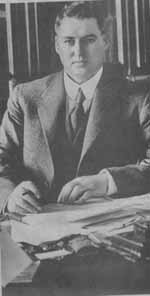 EG Theodore in the 1920s (AthertonTableLandNetGuide)
EG Theodore in the 1920s (AthertonTableLandNetGuide)
The most radical government which Australia has ever seen set about increasing Queensland’s pastoral rents to break up the big estates. The City of London warned that these moves would make it harder for Queensland to raise loan funds. Premier EG Theodore denounced ‘the bondage of despotism of the money lenders of London’. He borrowed from New York where interest rates were higher and so had to retreat.
Tom Cochrane’s Blockade: The Queensland Loans Affair 1920 to 1924 (full text) UQP, St Lucia, 1989)
reveals how the direction of society can be altered by a major political crisis. The Queensland loans affair of the 1920s led to just such a change in direction. After four years of economic sanctions by British pastoral interests, the State’s Labor government was forced in 1924 to abandon its action against the low pastoral rents paid by privileged squatting interests. The outcome was seen as a comprehensive victory for capital, and one which left a permanent stamp on the future of Queensland …
The loans affairs heralded the conversion of the radical social thrust of the 1920s into the profoundly conservative political approach that has characterised successive Queensland governments ever since. (Book blurb)
Cochrane explains that his book
inspects the effect of an economic blockade imposed on the State of Queensland in the early 1920s. The blockade was launched in response to the Queensland Labor government’s action against the privileged position of squatting interests in paying low pastoral rentals. Such action had been threatened by previous governments (on both sides of politics), but had been hitherto thwarted, either within Cabinet (as in 1910), or by the Upper House (from 1915 onwards). But in 1920 a newly-acquired Labor majority in the Upper House ensured the passage of the change, and British pastoral interests reacted with this economic sanction.
The impact of this blockade on Queensland’s economic and political affairs is examined; and it is shown that dislocation of the state’s economy, resulting in high unemployment, forced retrenchments and the abandonment or deferral of government schemes, was the result of this depletion of the government’s loan revenue. It is argued that the impact on the economy generally, for which there is wide and diverse evidence, is more readily understood by focusing on two events in particular: the boom and contraction of the cotton industry, and the abandonment of the plans for a large state-owned steel industry. (‘Preface’, Blockade, pp. xi-xii.)
(See also CB Schedvin, ‘E G Theodore and the London Pastoral Lobby’, Politics, 6, May 1971, pp. 26-41.)
…
1930s depression
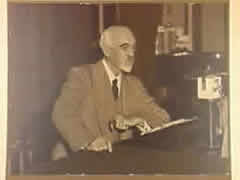 Sir Robert Gibson (Parliament of Australia)
Sir Robert Gibson (Parliament of Australia)
Federal Labor returned to office in November 1929 with a majority in the House of Representatives but with only seven out of the 36 Senators. The Senate blocked Labor’s Central Reserve Bank Bill, as Stuart Macintyre writes:
The sovereignty had become painfully apparent. Control over the money supply rested with the Commonwealth Bank as a result of Bruce’s legislation of 1924, was run by a board of business and financial leaders appointed by the government but not responsible to it. The chairman of the Commonwealth Bank Board was Sir Robert Gibson … who brooked no interference in his management of the country’s finances. Behind him stood the private banks, even more hostile to what they described as political interference in financial affairs. They arranged for the Senate to prevent the passage of the Central Reserve Bank Bill, which proposed merely to separate the trading bank activities of the Commonwealth Bank from its limited reserve bank activities, but alarmed the business community because of its provision for the appointment of a new reserve bank board. (Stuart Macintyre, The Oxford History of Australia, volume 4, 1901-1942, OUP, Melbourne, 1986, pp. 256-7.)
Sir Otto Niemeyer arrived on 14 July 1930 from the Bank of England to protect British investments. In August, the Premiers Conference endorsed Niemeyer’s deflationary policy.
(See: Peter Love, ed., ‘Niemeyer’s Australian Diary’, Historical Studies, 20 (79), October 1982, pp. 261-77; Bernard Attard, ‘The Bank of England and the origins of the Niemeyer mission, 1921-1930’, Australian Economic History Review, 32 (1), March 1992, pp. 68-83.)
‘Confounded impudence’: the Lang Plan
Federal Treasurer Theodore drew on a decade of international thinking about the virtue of inflationary public spending to stimulate economic recovery. He proposed to issue £18 million. The correctness of this response against demands to cut government spending to balance the budget became orthodoxy during the post-war trough in unemployment. For reasons connected with New South Wales Labor Party machinations, its newly elected Premier Jack Lang had to come up with a popular alternative to Theodore’s Plan and to that of Niemeyer.
Each of the three parts to the Lang Plan was sensible in itself, and several times more so than the Plan that the zombie professorate, led by Douglas Copland, had come up with under the tutelage of the Bank of England’s emissary. In February 1931, with jobless rates already over 20 percent, Lang called on the conference of the seven governments of Australia to support the following:
-
That the governments of Australia decide to pay no further interest to British bondholders until Britain had dealt with the Australian overseas debt as Britain settled her own foreign debt with America; [extended repayment to sixty-two years, etc.]
-
That, in Australia, interest on all government borrowing be reduced to 3 percent;
-
That immediate steps be taken by the Commonwealth Government to abandon the gold standard of currency, and set up in its place a currency based upon the wealth of Australia, to be termed “Goods Standard”.
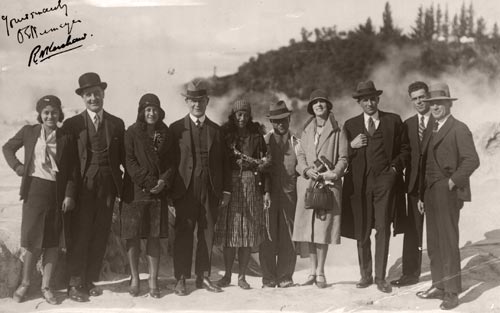 Sir Otto Niemeyer (4th from left) and friends visit Rotorua, New Zealand, 1930 (Te Ara Encylopedia of New Zealand)
Sir Otto Niemeyer (4th from left) and friends visit Rotorua, New Zealand, 1930 (Te Ara Encylopedia of New Zealand)
Australia had de facto left the Gold Standard earlier. Then, under the leadership of Alfred Davidson, the Bank of New South Wales broke the official exchange rate of parity with sterling early in 1931. (CB Schedvin, ‘Sir Alfred Davidson’, Australian Financiers, pp. 346-7.) Since 1933, Australian banknotes have not carried a promise ‘to pay the bearer one pound in gold on demand’.
Two qualifications hover over any endorsement of the Lang Plan. First, Lang had not jumped the gun on Keynes, whose prescriptions had been widely understood a decade before he gave them a theoretical foundation in his General Theory in 1936. Secondly, the Lang Plan suffered from an unavoidable weakness: failure to pay up in full would have shut down all loans. When Lang failed to repay £737 000 to the Westminster Bank, a loan which the Bank had refused to renew, the Commonwealth had to cough up. (David Clark, ‘Was Lang right?’, Heather Radi & Peter Spearritt, ed., Jack Lang, Hale & Iremonger, Sydney, 1977, pp. 138-59.)
The difficulties in rolling over loans continued under the anti-Labor government. (See: Neville Cain & Sean Glynn, ‘Imperial relations under strain: the British-Australian debt contretemps of 1933’, Australian Economic History Review, 25 (1), March 1985, pp. 39-58.)
The battle of the Plans raged until the State Governor, Sir Phillip Game, dismissed Lang in May 1932. Since New South Wales was still constitutionally a British colony, Game acted within his powers and betrayed none of the duplicitousness of Kerr in 1975. What the two dismissals do have in common is that both were sparked by challenges to the ‘Money Power’. (John M. Ward, ‘The Dismissal’, Jack Lang, pp. 160-78.)
In reaction to Lang’s alleged ‘repudiation’, RG Menzies told a Pleasant Sunday Afternoon in a Melbourne Methodist Church in May 1931:
If Australia were to get through her troubles by abating or abandoning traditional British standards of honesty, or justice, of fair play, of resolute endeavour, it would be far better that every citizen within her boundaries should die of starvation within the next six months. (Argus, 4 May 1931, p. 6.)
1946-49 nationalisation
Full and partial takeovers of banks during the chaos of 2008-09 revived interest in their nationalisation as a good thing in itself. This notion has significance here because the Chifley government’s attempt to do so in the late 1940s served as a sop to ‘true believers’ in Old Labor’s milk-and-water Socialist Objective. Hence, it is important to understand that Chifley was not taking the first step towards socialism. He was capitalising manufacturing capitals. His banking bills organised capital just as his sending the army into the coalmines disorganised labour in 1949.
Chifley had shared the labour movement’s distrust of bankers before an openly anti-labour government appointed him to the Royal Commission on Banking in 1935. His 18 months as Commissioner allowed him to refine his prejudices as he gathered testimony about the banks’ reluctance to invest in manufacturing. In Britain, the 1931 Macmillan Committee had revealed a comparable problem. (Peter Cochrane, Industrialisation and Dependence: Australia’s Road to Economic Development 1870-1939, UQP, St Lucia, 1980, pp. 55-73.)
As Treasurer from October 1941, Chifley used the Defence Power in section 51(v) of the Constitution to implement many of the Royal Commission’s recommendations. Knowing that those Regulations would lose their force during the transition to peace, Chifley secured Acts in 1945 to make them permanent. He saw these legal changes as pivotal to the reconstruction of capitalism after the 1930s depression through four interdependent projects: unemployment of no more than 5-7 percent; industrialisation (e.g. General Motors); power from the Snowy Mountains Hydro-Electricity Authority (which would also fuel a nuclear cycle for weapons); doubling the population, half through immigration. Controls over the trading banks seemed essential for this program.
The 1945 Act made State and local governments bank with the Commonwealth, which promised its trading arm more funds to assist manufacturing. For administrative reasons, this provision could not be implemented until May 1947, whereupon the Melbourne City Council successfully challenged its validity in the courts. Only then did Chifley move to nationalise the banks, fearful that reconstruction was being sabotaged. Menzies, for instance, spoke out against the Snowy Scheme.
In 1949, nationalisation was ruled ultra vires under section 92 of the Constitution which reads that ‘trade, commerce and intercourse … among the States shall be absolutely free’. A majority of the Bench and at the Privy Council contorted the meaning of ‘free’ from its original intent of not being subject to tariffs into meaning free from government restriction.
(AL May, The Battle for the Banks, SUP, Sydney, 1968; Warwick Eather & Drew Cottle, Fighting from the Shadows: The Private Trading Banks, Political Campaigns and Bank Nationalisation 1930-1949, Australian Centre for Labour and Capital Studies, Shanghai, 2012; Warwick Eather, ‘“Throw out the Socialists … we hold the destiny of this country in our hands”: The Australian Women’s Movement Against Socialization in New South Wales, 1947-1960, Australian Centre for Labour and Capital Studies, Shanghai, 2012.)
…
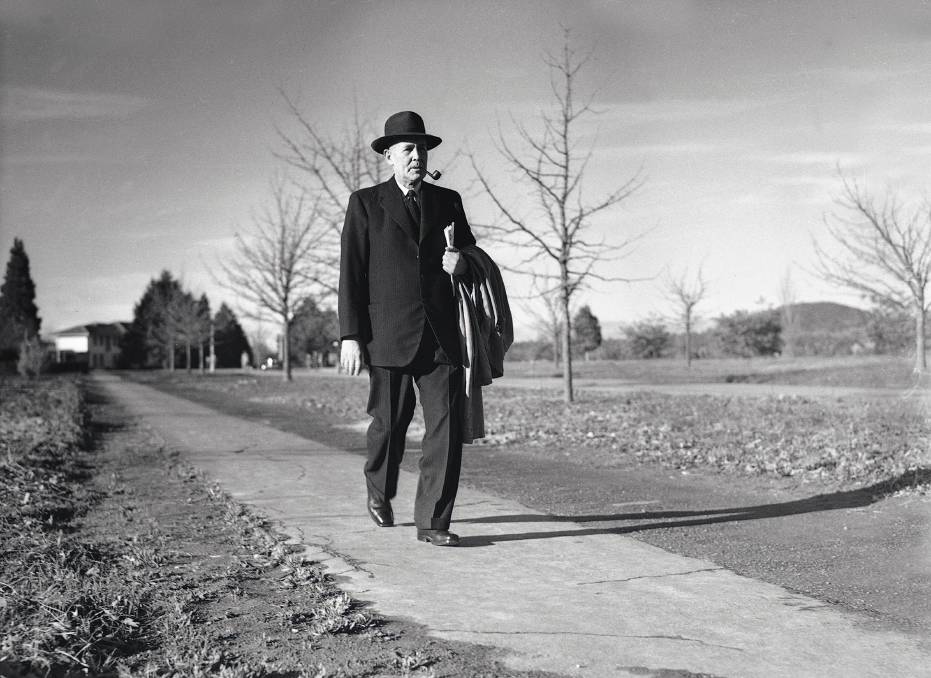 Former prime minister Chifley, Canberra, c. 1950 (Western Advocate)
Former prime minister Chifley, Canberra, c. 1950 (Western Advocate)
Who is to be done?
How should Marxists respond to the calls for a Royal Commission? The scandals provide a counter to the assault on the CFMEU and we must continue to build on the public’s outrage. Hence, it is tactically sensible to back demands for a nation-wide Independent Commission against Corruption to keep the anti-capitalist pot boiling.
The fallout from Piketty, Pope Francis, Corbyn and Sanders is melting down barriers that had kept radical ideas for social equality off the agenda for over 30 years. The welcome given to their criticisms of real existing capitalism is being fed by the ongoing implosion in the expansion of capital. Since that actuality will get worse long before it starts to improve, Marxists have ample opportunities to take advantage of the spaces that have opened up to deepen public awareness of how the banks serve global capital. To get those connections across, we need first to listen to how the turmoil is misunderstood. Nothing will be gained from megaphone Marxists who know all the answers without ever having heard any of the questions.
No Royal Commission will deliver much of what wage-slaves need most. No government is going to repeat the mistake that led to the revelation of bottom-of-the-harbour tax schemes, or the Gyles Royal Commission into the New South Wales building unions which ended up with the Master Builders in the dock. Both the Cole and Heydon Royal Commissions into the unions had terms of reference framed to protect the guilty. Should public pressure broaden the scope of any inquiry, the selection of the Commissioners can keep a tight rein on where the investigation heads.
The first rule for governments in setting up any Royal Commission is to write the findings before the terms of reference – or as the Queen says in Alice: ‘Sentence first – verdict afterwards!’ The Report of the 1936 Commission was little more than milk-and-water amendments, largely on technical matters. All the inquiries from the Campbell Report in 1980 onwards have had the pre-set purpose of giving open slather to the money-movers and jugglers, like the Victorian inquiry in 1887. David Murray’s recommendations for Abbott-Hockey proved slightly different because, fearful of the coming global shocks, he called on the banks to strengthen their liquidity – a requirement which eats into their profits.
Any reforms out of a Royal Commission, like those from the bigger budget and greater powers for the Australian Investment and Securities Commission, will oblige the agents of capital to find new ways around and through the law, aided by High Court judges and ‘free’-trade Agreements. For the present, we can enjoy watching pressure from social movements trim the ‘culture’ of profit-taking. However, global capital will never break out of its current implosion if shackles on financiers get in the way of the next bout of exploiting wage-slaves, plundering the wealth of nature and swindling customers of every magnitude, whether rival conglomerates or a widow out of her mite.
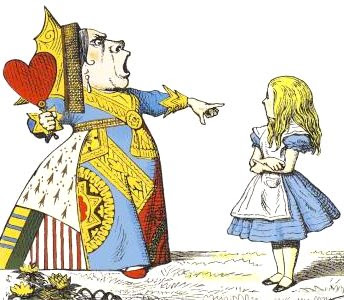 ‘No, no!’ said the Queen. ‘Sentence first – verdict afterwards.’ (Gates of Vienna Blogspot/Sir John Tenniel)
‘No, no!’ said the Queen. ‘Sentence first – verdict afterwards.’ (Gates of Vienna Blogspot/Sir John Tenniel)
[*] For those who did not pick it up, the title of this article mashes together the former slogan of the Commonwealth Bank and Oberon’s lines from A Midsummer Night’s Dream, ‘I know a bank whereon the wild thyme blows …’, which was once adapted as a slogan by the then Bank of New South Wales.


Hi Tony
Sounds like a good subject. The drum on SFL might well be here https://researchdirect.westernsydney.edu.au/islandora/object/uws:16079 We did a quick search ‘Sound Finance League’ and threw up some publications also. Suggest William Kennedy McConnell might be the main man, though, as I recall FA Bland was in on the IPA early days also. Certainly would have been overlap. Main lobbyist for the banks by the late 1940s was Leslie McConnan https://adb.anu.edu.au/biography/mcconnan-sir-leslie-james-10916 . There was a lot of overlap between these blokes and the organisations they set up. It was a time when Labor was on top and capital had to use whatever means it could to fight back! 1949 election in Australia was at Trumpian standards of nastiness. David Stephens HH.
Hi
I’m looking at the same period 1936-1959 for a novel and have come across a reference by Minister Dedman referring to the “Sound Finance League” funded by the banks (2nd reading speech 22/3/45 https://historichansard.net/hofreps/1945/19450322_reps_17_181/#debate-19). I cannot find anything on this group – were they a precursor to the IPA? Anyone know anything?
Thanks
Tony